Gyanvimal Sazzay Sangraha
Added to library: September 1, 2025

Summary
This comprehensive summary outlines the "Shri Gyanvimal Sazzay Sangraha," a collection of devotional poems (sazzay) by Acharya Shree Jnanavimalsuri, edited by Kirtida Shah and Abhay Doshi, with Vinodchandra Ramanlal Shah as the assistant editor. Published by Shri Gyanvimal Bhaktiprakash Prakashan Samiti in 2003, it contains 84 such poems, categorized into "Tattvavicharatmak Sazzay" (philosophical/doctrinal) and "Kathanatmak Sazzay" (narrative).
Key Aspects of the Book:
- Content: The collection focuses on the "sazzay" compositions of Acharya Jnanavimalsuri. It also includes some previously uncollected works in an appendix, such as stanzas from the "Kalyan Mandir Stotra," a hymn to Mallinath incorporating the significance of "Maun Ekadashi," and other devotional pieces.
- Editorial Process: The editors sourced the sazzays from 19 published collections and a few manuscripts. They acknowledge the assistance of Panayshri Niranjanvijayji for providing four volumes of the "Swadhyaya Sangraha" edited by Nagindas Patadiwala and other sources.
- Definition of Sazzay: The book clarifies that "sazzay" is a Jain technical term originating from the Sanskrit word "Swadhyay," meaning self-study or the study of the soul. It is considered the twelfth type of austerity and an inner penance that acts as a prelude to meditation and Kaussarg. In contemporary Gujarati, "sazzay" refers to metrical compositions in devotional or laudatory styles in local languages.
- Themes and Style: Acharya Jnanavimalsuri's sazzays explain the essence of scriptures and also narrate stories of great souls. His philosophical sazzays, like the "Yatidharma ni Sazzay" (spanning ten sections and various couplets), are noted for their depth and style, reminiscent of the poet Narsinh Mehta. Other significant philosophical works include the "Navkar mantraabhas" or "Panch Parmeshthi ni Sazzay," effectively describing the virtues of the five supreme beings. The narrative sazzays often draw from Jain traditions, featuring characters like Sudarshan Sheth and Sulsa Sati, as well as lesser-known figures like Devkuvar Rishi and Ratnamala's five brothers. The collection showcases the poet's ability to imbue religious narratives with emotion and engaging descriptions.
- Structure: The sazzays are classified into two main categories:
- Tattvavicharatmak Sazzay (Philosophical/Doctrinal): These poems delve into Jain principles, practices, and philosophical concepts. Examples include those on the eleven Angas and twelve Upangas, the doctrine of manifold predications (Ashotnayabhangi), the twenty virtues of a muni, the twenty-one virtues of a layman, the significance of the Navkar mantra, the nature of renunciation (vairagya), and the path to liberation (moksha).
- Kathanatmak Sazzay (Narrative): These poems recount stories of revered figures from Jain tradition, such as Sudarshan Sheth, Avanti Sukumal, Chandanbala, Bahubali, and others. They often highlight moral lessons and devotional aspects.
- Notable Poems: The book highlights several key poems, including:
- Yatidharma ni Sazzay: Expands on the conduct of Jain ascetics.
- Sukhia ni Sazzay: Describes the characteristics of a truly happy Jain, comparing them to the Vaishnava concept of a "true devotee."
- Kayal Kamini ni Jeev Swami ne Updeshak Sazzay: Presents a unique perspective where the body (Kaya) advises the soul (Jeeva), urging the soul to utilize the human form for spiritual welfare.
- Mokshanagar ni Sazzay: Offers a metaphorical description of the city of Moksha and the journey towards it.
- Editorial Acknowledgements: The compilers express gratitude to various individuals and institutions for their support, including Acharya Shri Pradyumansurishwarji for inspiration, Nagedas Patadiwala for compiled works, various Jain Bhandars in Patan and Limbdi, Dr. Jayant Kothari (to whom the publication is dedicated), Dr. Kumarpal Desai for encouragement, and Prof. Kirtidaben (Joshi) Shah and Prof. Abhay Doshi for their editorial assistance. They also acknowledge the financial contributors and mention that copies will be gifted to Sadhus, Sadhvis, Gyanbhandars, and libraries.
- Future Plans: The committee intends to publish a collection of spiritual songs from all four divisions of Jain literature in the future and invites suggestions and contributions from literature enthusiasts.
- Biographical Information: The book provides biographical details about Acharya Jnanavimalsuri, noting his birth in 1694 AD, his ascetic life under Pandit Dhirvimalgaccha, his mastery of languages and literature, his significant literary output in Sanskrit, Prakrit, and Gujarati, and his contributions to Jain scholarship and activism. It also mentions his passing in 1782 AD and the erection of his footsteps (pagla) memorial in Khambhat.
- Appreciation: The editors highlight the richness and diversity of Acharya Jnanavimalsuri's sazzays, covering various aspects of Jain doctrine, ethics, and stories of spiritual practice. They express hope that the collection will inspire readers and contribute to the dissemination of spiritual knowledge.
- Glossary: The book includes a glossary, though it notes that terms specific to Jain philosophy were not included.
In essence, "Shri Gyanvimal Sazzay Sangraha" is a significant compilation of devotional poetry by a revered Jain Acharya, offering profound insights into Jain philosophy, ethics, and the lives of spiritual exemplars through engaging and accessible verse.